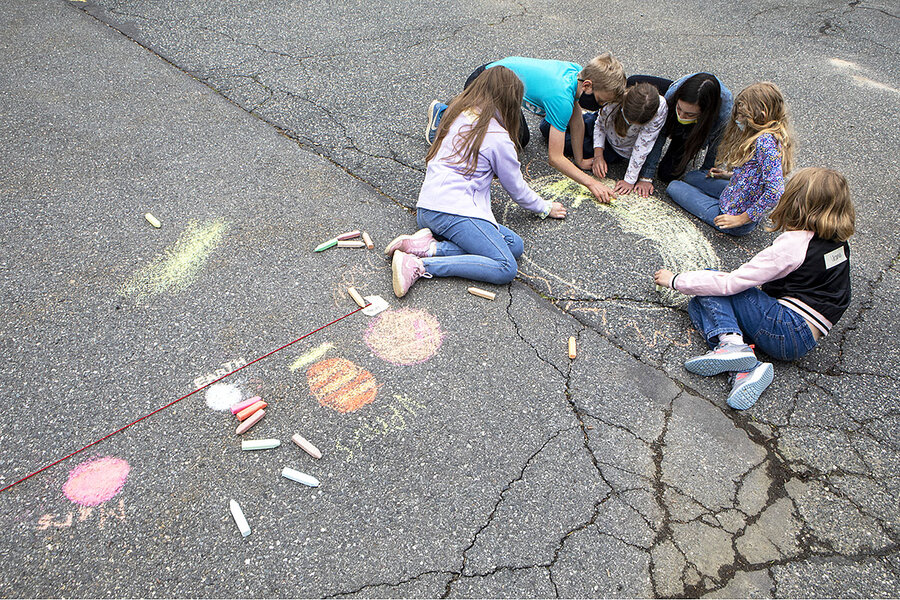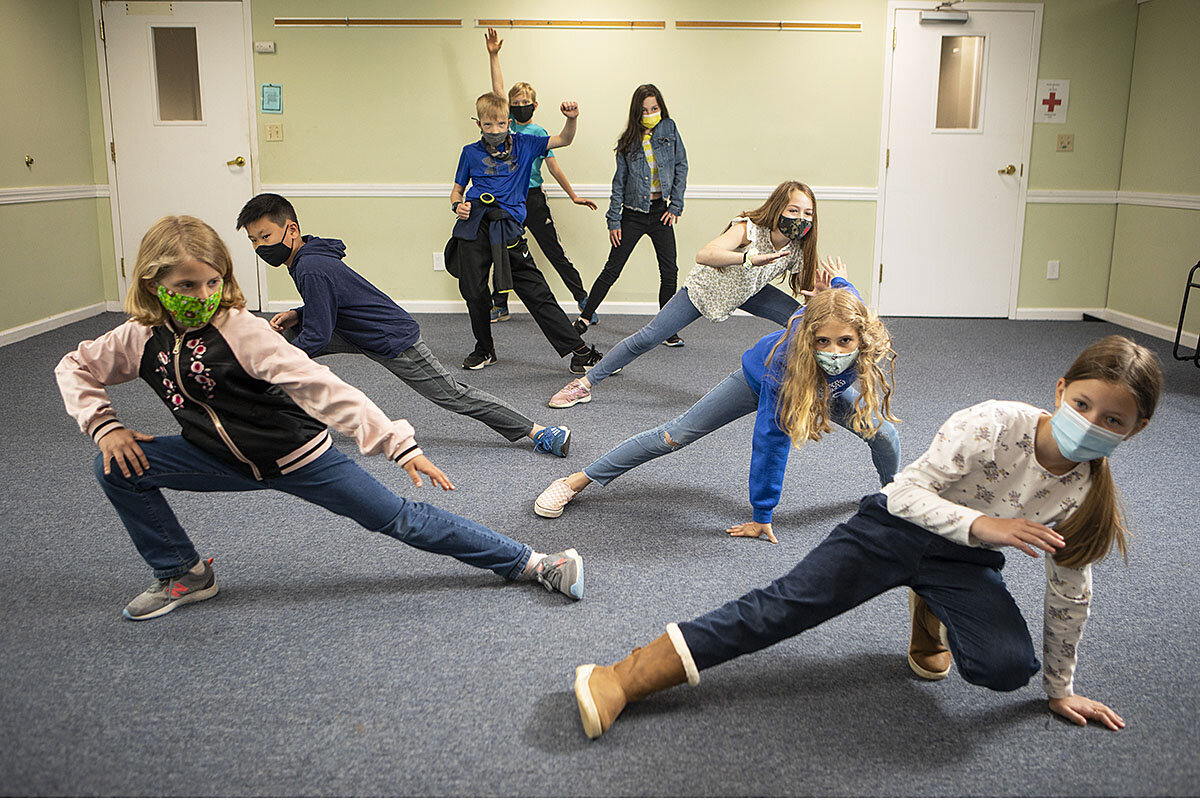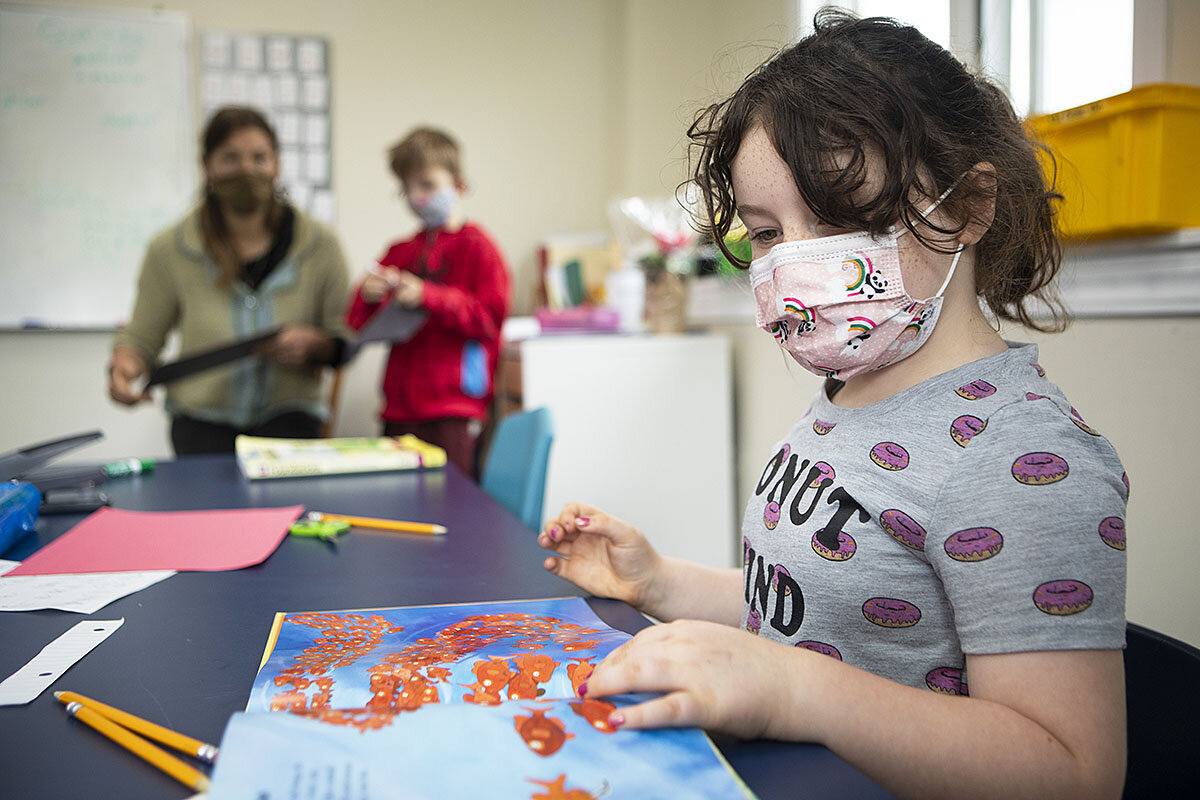Parents eye another option for fall: Hybrid home schooling
Loading...
| Needham, Mass.
Amanda Holley and her family used to enjoy walking to a nearby public elementary school. Now, a local school isn’t a part of the plan: Ms. Holley home-schools three days a week and sends her children to school elsewhere the other days.
The approach is dubbed hybrid home schooling and Ms. Holley plans to stick with it. Two days a week, she drives her daughters to Grace Preparatory Academy in Needham, Massachusetts, a 30-minute commute from their house in a suburb north of Boston. On the other days, the school provides lessons that she teaches at home.
“We went back and forth” about whether to go back to public school next year, says Ms. Holley, who works part time while her two children are at school. “But our girls have had such a positive experience, and more so than we would have expected, so we made the decision to stay.”
Why We Wrote This
As parents consider how to make the school experience better, some are exploring hybrid home schooling. What might this interest suggest about how flexible families want education to be moving forward?
Lines between school and home have significantly blurred during the pandemic, including families overseeing remote public schooling or shifting to home schooling or learning pods. Parents are now making decisions about where to send their children next year, a task complicated by questions about remaining safety precautions come fall and, for some families, the timeline for vaccines for children under 12. Parents experimenting with education options that meld learning both inside and outside the home will likely continue, observers say, as families prioritize flexibility and safety.
“The whole notion of what counts as home schooling is continuing to evolve,” says Robert Kunzman, an education professor at Indiana University and managing director of the International Center for Home Education Research.
Given the involvement of parents at home this past year, he says, “it can’t help but create a greater awareness of the possibilities and the ways in which education and formal schooling isn’t limited by a building or a particular schedule necessarily. Those are things that will probably continue to resonate in our cultural conception of education moving forward.”
In a nationally representative survey of parents conducted monthly since March 2020 by Morning Consult and EdChoice – a nonprofit supporting school choice policies – parental support for some form of hybrid education after the pandemic consistently hovers around 40%, says Michael McShane, author of the book “Hybrid Homeschooling” and EdChoice’s director of national research.
Interest in home schooling also spiked in the past year. The number of students home-schooled in the United States in the 2020-21 school year climbed from an average of around 3% to just over 11%, according to a March report by the United States Census Bureau. Home-school participation rose across all racial and ethnic groups, including to more than 16% of Black households and more than 12% of Hispanic households.
Hybrid home schooling existed pre-pandemic in public and private schools, says Dr. McShane, noting that he’s seen an increase in formal hybrid home schools over the past few years and expects the pandemic to reinforce the trend.
“I think there is clearly a ton of demand for these schools. The big question is will supply rise to meet that demand,” says Mr. McShane, who supports expanding school choice options, like vouchers, to make tuition-based programs more widely available for lower-income families.
In Colorado, for example, the Department of Education lists 19 public schools and districts that already sponsor some type of in-person home-school programs. Public schools in several states receive funding from their state government for home-school students who attend one or two classes. Some traditional private schools offer home-school students the option to sign up for individual courses.
“The openness of especially public schools, and the market-awareness of private school providers, has increased in terms of seeing home-schoolers as potential educational partners,” says Professor Kunzman. While that can be a plus for schools and students, it can also chip away at the sense of community that many schools try to build, he notes.
“There are lots of benefits and values to cultivating a community of learners in a school setting and a community of school citizens, and I think it does get more complicated when you have students in a more a la carte framework, dropping in and out,” he says.
Other concerns involve the quality of home schooling and wealth disparities. In a May report by Tyton Partners, an advisory and investment firm, and the Walton Family Foundation, 55% of lower-income families who started home schooling this year are not spending any money on home schooling, while 51% of high-income families who are home schooling report spending more than $500 per month.
Growing to meet demand
Schools throughout the United States are figuring out ways to meet demand. Grace Preparatory Academy in Needham, where Ms. Holley’s girls attend several days a week, grew out of a home-school co-op formed by parents in 2012. Massachusetts considers it a tutoring service, but the school is undergoing accreditation this spring by the Texas-based nonprofit NAUMS Inc., which oversees University-Model® schools. The University-Model® network considers its schools private Christian schools. Grace Prep plans to apply with the Needham school board for private school status after it earns accreditation.
Enrollment at the school grew during the pandemic: Five families joined midyear, an anomaly in the school’s enrollment patterns. Currently, 47 students are enrolled for next year and the school is considering hiring an additional teacher for an extra classroom if more students enroll. Families are drawn to the faith-based education, and the school attracts parents who “want to homeschool ... but don’t want to do it on their own,” says Jenna Wertheimer, the school’s program director.
Tuition fees are $3,900 per student annually and the school offers financial aid. By comparison, a private school located nearby with five days of in-person schooling charges $32,950 for kindergarten and $41,275 for fifth grade. Recruiting teachers to work part time and maintaining strong communication between parents and the school are Grace Prep’s biggest challenges, Ms. Wertheimer says.
Across the country in Colorado, Mountain Phoenix Community School, a public, Waldorf-inspired charter school in Wheat Ridge, has offered a home-school enrichment program since 2013 – including Spanish, art, and orchestra. Enrollment has grown over time from a handful of students to 140 children for the 2021-22 school year. The program is expanding to a new building as a result.
“I think parents are finding that maybe their child is not excelling in a traditional public school classroom,” says Lynn Pollitt, director of the home-school program at Mountain Phoenix. “If they still don’t want their child five days a week in a brick and mortar school [they may] want the enrichment piece that the home-school program offers.”
Beyond one-size-fits-all
Families are often attracted by the flexibility that hybrid home schooling offers. Khadijah Ali-Coleman’s 18-year-old daughter was dual-enrolled and earned an associate degree at a community college while finishing high school via home schooling. Her daughter will attend a four-year university in California this fall.
“My daughter is a Black family home-schooling success story,” says Dr. Ali-Coleman of Fort Washington, Maryland, who co-founded the Black Family Homeschool Educators & Scholars group last year, and is co-author of a forthcoming book on home schooling Black children in the U.S. Dr. Ali-Coleman was able to home-school her daughter by searching out flexible work that enabled her to bring her daughter with her.
“[The book] puts to rest this myth that home-schooling parents look the same and we do all the same things. I am in a domestic partnership, but we’re not married. I’m a working mother and have been working throughout home schooling, and we’re working class, very much working class,” she says.
Back in Massachusetts, Ms. Holley says the decision to hybrid home-school her daughters means she’s had to figure out how to juggle wearing the hats of mom, teacher, and part-time professional. But she considers the extra time with her daughters and their learning rewarding.
“It’s been great to have time with them ... and see the curriculum more than I did when [my oldest daughter] was at school for seven hours a day, five days per week. It’s been really nice to be hands on and more a part of their learning experience.”








